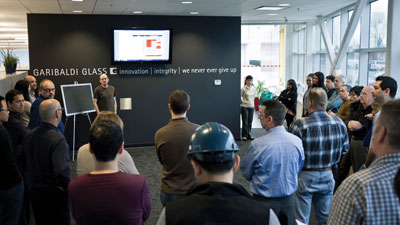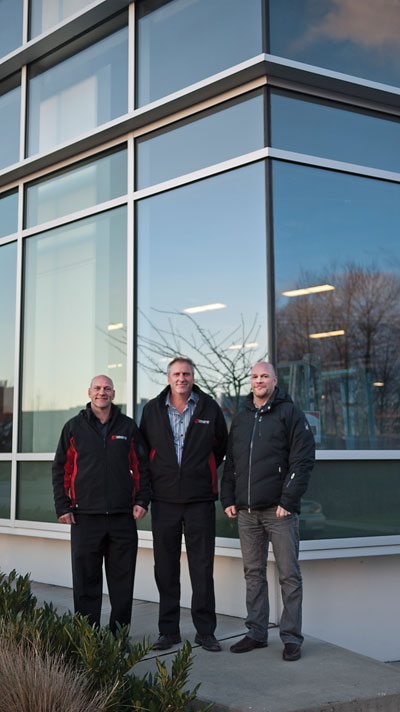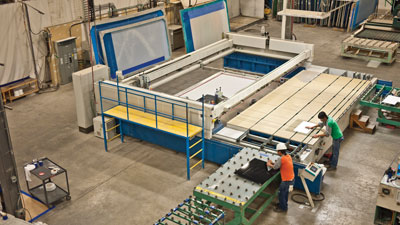
Features
Community
Under the Glass
Determined to be good
Shortcuts hold little appeal for Garibaldi Glass.
February 13, 2013 By Patrick Flannery
So often in life and business, we are tempted by the easy way out. We can always see the right path, the path of integrity and correct action, but so many attractive shortcuts present themselves.
So often in life and business, we are tempted by the easy way out. We can always see the right path, the path of integrity and correct action, but so many attractive shortcuts present themselves. Paths that incur less risk, that involve less time or energy or worry. Paths that work well in the short term at the cost of our long-term welfare. The story of Garibaldi Glass is the story of three brothers who were determined to take the right path, and stuck to their best understanding of the correct way to do business even when formidable obstacles and easier ways out presented themselves. The result has been the formation of one of North America’s most innovative and respected custom glass fabricators, with a shiny new facility and a book of business that could be the envy of anyone in the glass construction industry around the world.
 |
|
| The staff huddle is an informal meeting a supervisor has with the whole Garibaldi team each morning. Sometimes the discussion is not even about work. Co-owner Carey Mobius feels these quick updates boost morale and keep everyone on the same page.
|
When the boys’ father, Bernd Mobius, had a heart attack in 1976 and died four years later at the age of 42, and the small glass shop he started in north Vancouver was on the brink of insolvency, it probably would have been easier for 18-year-old Carey to let it fail and let his mother, Doris, find some other way to support the family. But Carey made the decision to keep his father’s business going because he and his brothers had grown up in that shop. When they were young, his father ran a pet shop out of the front of the business so the boys would have something to do while he and their staff worked inside. It worked well, because other children would come into the shop and play with the Mobius boys and the pets. So, when the bank told the Mobiuses that the shop was going out of business in six weeks, Carey, two weeks away from graduating high school, stepped in to take over. “What we did at that time was worked out asses off on the phones in the front end by day,” Carey remembers. “We were really just buying one stock sheet at a time from the vendors as the orders came in just to keep our doors open, and that went on for years. Just growing some legs again. We’d be on the phones by day then stick around to do our cutting or whatever we had to do at night so it could go out with the glaziers in the morning, then be back on the phones. Back then it was seven days a week, probably an average of 14 to 16 hours per day.”
This determination brought Garibaldi back to viability as a custom fabricator and installer for commercial and high-end residential homes. Carey’s brothers, Chris and Craig, joined the company full -time as they graduated high school through the ’80s, with Chris gravitating toward production as the company’s VP Operations, and Craig concentrating on sales. Carey has the CEO title. Carey is proud of the fact that two of the company’s original employees are still with Garibaldi: Nick Meissner and Betty Scott, who recently retired at the age of 71. The focus on team is another area where the Mobiuses refuse to compromise on best practices. First thing every morning, the entire administrative workforce gathers for what they call “the Huddle.” Various supervisors guide them through a discussion of what has happened recently, what is planned for the day and what is upcoming on the work schedule. Other company news and updates are passed along, and even personal notes about things in the staff’s lives they wish to share. These meetings frequently end with a number of smaller breakout meetings where staff from different areas of the organization take the opportunity to co-ordinate their efforts on specific projects. The whole thing takes between 10-15 minutes and delivers a great boost to morale and interdepartmental communication.
 |
|
| From the left are Carey, Chris and Craig Mobius in front of Garibaldi’s test wall. The test wall allows architects to view full mock-ups of their designs up to 55 by 88 inches in size, including spandrels if necessary.
|
Another early milestone was the acquisition of a horizontal tempering furnace in 1990 to replace the old tong-hung one they had. This marked the beginning of another Garibaldi trait that would characterize the company going forward: a willingness to tackle any manufacturing challenge and build the equipment and competencies necessary on the fly. “We didn’t have the funds to buy a proper [furnace],” Carey remembers, “so we had to buy one that was dysfunctional. It was a 30-inch and we bought it for next to nothing and that became our project for the next year. Ernie, Nick, Betty and a few others – every night, every weekend we would break it down, build what we could, buy appropriate parts and try to make it work again. We pulled it out of the plant every single day. We literally put all the equipment in a road in a fairly busy area and we came out one day and there was an actual parking ticket on our tempering furnace because we had taken a parking spot.” Chris is confident in saying Garibaldi had the first horizontal tempering furnace in western Canada. It is probably even more certain that it has the only parking ticket issued to a tempering furnace anywhere in the world. In any case, the fearless early adoption of new technology has rolled on throughout the company’s history.
In 1999, the Mobius brothers were once again pushed to the wall and given a choice to take bold action on behalf of the company, or to risk failure. Garibaldi had always been a service company, with an installation side that made up about half the business. In 1997, growth forced a move from its north Vancouver origins to a 42,000-square-foot leased facility in Burnaby, B.C. The move stretched the company’s resources, then the recession of the late ’90s bit. By 1999, circumstances were becoming dire.
| Location: Burnaby, B.C. No. of staff: 150 Plant: 160,000 sq.ft. Owners: Carey, Chris and Craig Mobius Founded: 1966 Garibaldi Glass provides custom glass fabrication, including doors and entranceways, curtainwall, marine glass, interior glass and special projects, to builders and homeowners in B.C. and around the world. Named after Garibaldi National Park near the company’s original location in Squamish, B.C., it is run by the three sons of its founder, Bernd Mobius. |
“We couldn’t figure out why we weren’t getting the business on the manufacturing end,” Carey remembers. “We had great equipment, great people, but a lot of people were not buying from us. And we couldn’t figure out what was going on and no one would speak to us even though we were friends with everybody.” The brothers did some soul-searching, then decided to shut down the contracting side of the business. It turned out to be exactly the right move. “Friends in the industry that we had known for years replaced every dollar we lost in installation within six weeks,” Carey says. “They said, ‘That is what we were waiting for. You are no longer a competitor of ours.’” Since then, Garibaldi has focused entirely on manufacturing with no installation component to the business.
The commitment to excellence is perhaps most evident in Garibaldi’s new 160,000-square-foot plant, opened in January, 2011. For years, Chris says, the brothers had dreamed of getting into a facility built to lean manufacturing principles. The Mobius brothers have a penchant for industry involvement and travel, and have toured dozens of glass fabrication plants all over the world, taking careful note of what they like and don’t like. “In the old days, we would open the phone book, when there still were phone books, and go visit a plant in the area,” Chris remembers. “We got a lot of ideas from that. Then, every single person who works here had a say in the design. We asked everyone to tell us what they would like to see in the new plant.” To this input, the brothers added some serious analysis to optimize the workflow. They created a spaghetti diagram to track the path of each common component as it moves through the shop, counting steps and touchpoints. Then they placed workstations to minimize those values, reducing the chances of worker fatigue, lost time and damage to workpieces. They also made a “blue sky” plan, placing every kind of equipment they could ever envision needing in the plant, with capacity for a tripling of production. This established, pre-planned layout allowed Garibaldi to bury all the power and plumbing for the shop floor in the slab. Adding new equipment will be as easy as setting it in place and pulling the utility lines up from the existing trench. Their hard work to set things up right today will save hours of time and thousands of dollars tomorrow.
The move itself was an exercise in refusal to take half measures. Every company wishes to minimize downtime in a plant move. Garibaldi took that principle to a new level. On Dec. 22, 2010, the old plant shut down for the last time. The entire workforce worked for 24 hours straight, then went home to spend Christmas with their families for the next two days. Everyone returned on the 27th, then worked through to Jan. 4 with a day-and-a-half break over New Year’s. “We moved an 85,000-square-foot, 24-hour-per-day facility from a full stop to full restart with all equipment, including the office, in six calendar days,” Carey says. “We moved the entire operation, including a double-bay tempering furnace. The vendor thought we were insane. They had never moved a furnace in less than five weeks.” To do it, Carey says, the team planned for two- and- a- half years and had the schedule down to 15-minute increments with unassigned people who could jump in and help the moment any team fell behind.
 |
|
| Frequent quality checks are routine at Garibaldi. Taking on challenging projects keeps employees sharp, so even the simpler tasks are done right.
|
Fear of new challenges is not in the Mobius DNA. The brothers happily jumped into a contract to supply glued-in marine glass for boat windows. Around 12 years ago, the company was approached to put a perimeter frit on some panes for urethane application. At the time, almost all marine windows were framed because of the challenges of vibration and thermal expansion coupled with the need for a durable, watertight seal. But this builder wanted a sleeker look, with glued-in glass. Garibaldi found that only one other company in the world was doing this kind of work at the time, and jumped at the opportunity to be second. “A large corporation would never have gone through the pain and suffering we went through to get good at marine because they would just look at the bottom line,” Carey says. “We look at the potential down the road. The reason we stuck to marine, even though it is not a big part of our business, is that it sets the bar for quality in our plant. So even if we are doing something as simple as railing glass, we minimize defects because the quality expectation is so high in our plant.”
One side effect of the Mobius’ unwillingness to compromise on best practices is they end up doing a lot of things for themselves that other companies would usually outsource. Take applying ceramic frit. When they saw opportunity in that market, they looked around at how others were doing it, briefly contemplated the price on new machines built in Europe, then decided to build their own. They called in frit supplier friends to advise and used their in-house machine-building expertise to construct their first screen-printing ceramic frit applicator. “We learned there is a line between too fine and too coarse on the application process,” Chris says. “The frit comes out like toothpaste through a screen. If you build it coarse, you get less detail but you can go faster.” The ability to screen-print ceramic frit has helped Garibaldi with its marine projects, its first big commercial project at 401 Burrard in Vancouver and many of the “crazy” requests the company gets from high-end custom homebuilders and commercial developments in the area. They can apply a wide range of patterns and colours, and have a method for using lines and dots to reduce heat gain through the glass.
 |
|
| Garibaldi’s ability to screen print custom ceramic frit patterns sets it apart from most North American glass fabricators. It can apply frit to sheets up to 80 by 160 inches and 3⁄16 to ¾-inch thick. Solid and translucent colours are available.
|
When it comes to being a good member of the glass community, Garibaldi once again takes the path less easy, but more positive. Each year, it hosts Garibaldi Glass Day: an educational event and tabletop show that attracts more than 500 people to the plant and the company throws a big party at the end. “One of the things I miss in this industry is the camaraderie that used to exist 15 or 20 years ago,” Carey says.
“There used to be so much more interaction between vendors and competitors. That is part of this. The industry needs to come together as one. Products are changing so fast we want to take the opportunity to have industry people share their knowledge.”
Carey can remember the day he realized that the only way forward for the company was to do things the right way, no matter how hard things got. “Back in 2000 when we were up against the ropes and didn’t know if we were going to make it because we were stretched so thin, it was actually a drive into work that did it for me,” he says. “I came across this bridge and it came on like a lightbulb. I realized right then and there that there are some people who go to work to make a profit for today and some who go to build a business. If you build a business and you build the model right and you stick to your goals and you stick to your values, the profits and the revenue should come in. That is what we have done ever since that day. Just stick to what we feel is right and don’t deviate from it.”
Garibaldi Glass Day 2013
- When: Friday, May 3, 2013
- Where: Garibaldi Glass, 8183 Wiggins St., Burnaby, B.C.
- How: Sign up online at www.garibaldiglass.com
- What: Guided tours of the state-of-the-art manufacturing facility, structural door department, CAD lab, and sales office. Plant and office tours need to be booked in advance.
Print this page
Leave a Reply